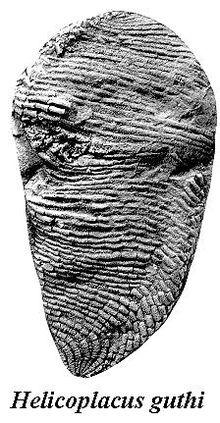| Revision as of 03:48, 9 August 2023 editInedibleHulk (talk | contribs)Extended confirmed users127,482 editsm The abyss was showing.← Previous edit | Revision as of 07:07, 13 August 2023 edit undoOAbot (talk | contribs)Bots442,978 editsm Open access bot: doi added to citation with #oabot.Next edit → | ||
| Line 26: | Line 26: | ||
| == Stratigraphic distribution == | == Stratigraphic distribution == | ||
| ''Helicoplacus'' is one of the earliest mineralizing echinoderms, appearing alongside close relatives ''Polyplacus'' and ''Waucobella'' in the ], among strata notable for an exceptional abundance of echinoderm fossils (including also edrioasteroid fragments).<ref name="Smith2013nc">{{Cite journal | url = https://www.nature.com/articles/ncomms2391/figures/3| title = Figure 3: Stratigraphic distribution of early to middle Cambrian echinoderms. | journal = Nature Communications | doi = 10.1038/ncomms2391}}</ref><ref name="Zamora2013">Zamora, S. ''et al.'' (2013). Cambrian echinoderm diversity and palaeobiogeography. In: Harper, D. A. T. & Servais, T. (eds). ''Early Palaeozoic Biogeography and Palaeogeography''. Geological Society, London, Memoirs, '''38''': 157-173. </ref> | ''Helicoplacus'' is one of the earliest mineralizing echinoderms, appearing alongside close relatives ''Polyplacus'' and ''Waucobella'' in the ], among strata notable for an exceptional abundance of echinoderm fossils (including also edrioasteroid fragments).<ref name="Smith2013nc">{{Cite journal | url = https://www.nature.com/articles/ncomms2391/figures/3| title = Figure 3: Stratigraphic distribution of early to middle Cambrian echinoderms. | journal = Nature Communications | doi = 10.1038/ncomms2391| doi-access = free}}</ref><ref name="Zamora2013">Zamora, S. ''et al.'' (2013). Cambrian echinoderm diversity and palaeobiogeography. In: Harper, D. A. T. & Servais, T. (eds). ''Early Palaeozoic Biogeography and Palaeogeography''. Geological Society, London, Memoirs, '''38''': 157-173. </ref> | ||
| The Poleta Formation is correlated with the as-yet unratified Cambrian Stage 3 (Series 2), giving it a provisional date of ~{{Ma|516}}.<ref>{{Cite book | | The Poleta Formation is correlated with the as-yet unratified Cambrian Stage 3 (Series 2), giving it a provisional date of ~{{Ma|516}}.<ref>{{Cite book | | ||
Revision as of 07:07, 13 August 2023
Extinct genus of marine invertebrates
| Helicoplacus Temporal range: ~ 516 Ma (Cambrian Stage 3) PreꞒ Ꞓ O S D C P T J K Pg N ↓ | |
|---|---|

| |
| Helicoplacus guthi | |
| Scientific classification | |
| Domain: | Eukaryota |
| Kingdom: | Animalia |
| Phylum: | Echinodermata |
| Class: | †Helicoplacoidea |
| Genus: | †Helicoplacus |
| Species | |
| |

| |
| Areas where Helicoplacus has been found | |
Helicoplacus (often misspelled Helioplacus) is the earliest well-studied fossil echinoderm. Fossil plates are known from several regions. Complete specimens were found in Lower Cambrian strata of the White Mountains of California.
The animal was a cigar-shaped creature up to 7 centimetres (2.8 in) long that stood upright on one end. Unlike more typical echinoderms such as sea stars, Helicoplacus does not have fivefold symmetry. Instead, there is a spiral food groove on the outside along which food was moved to a mouth that is thought to be on the side. The respiratory system appears to be primitive. Although the animal does not look like a typical echinoderm, the plates are composed of the characteristic calcareous plates known as stereom that are common to all echinoderms. The ambulacrum is similar to that of the Edrioasteroidea; as a result, Helicoplacus may belong to Pelmatozoa.
Other contemporaneous echinoderms are known to have existed from their dissociated plates, but other than a few possible edrioasteroids, Helicoplacus is the earliest echinoderm that is well enough preserved to analyze its characteristics. One much earlier form called Arkarua has been hypothesized to be an ancestral echinoderm because of its fivefold symmetry, though it appears to lack stereoms and a mouth. Template:Early Echinoderms graphical timeline
Helicoplacus is thought to have been a suspension feeder living at moderate depths in highly oxygenated water with strong enough currents to ensure a steady food supply. It is typically found in greenish shales and, rarely found in shallow water sandstones and limestones. The helically spiraling rows of plates radiating from the base, which in life probably was anchored in the muddy substrate.
Stratigraphic distribution
Helicoplacus is one of the earliest mineralizing echinoderms, appearing alongside close relatives Polyplacus and Waucobella in the Poleta formation, among strata notable for an exceptional abundance of echinoderm fossils (including also edrioasteroid fragments).
The Poleta Formation is correlated with the as-yet unratified Cambrian Stage 3 (Series 2), giving it a provisional date of ~516 million years ago.
See also
References
- ^ Zamora, S. et al. (2013). Cambrian echinoderm diversity and palaeobiogeography. In: Harper, D. A. T. & Servais, T. (eds). Early Palaeozoic Biogeography and Palaeogeography. Geological Society, London, Memoirs, 38: 157-173.
- Durham, J.W., & Caster, K. E.; Caster, KE (17 May 1963). "Helicoplacoidea: A New Class of Echinoderms". Science. 140 (3568): 820–822. Bibcode:1963Sci...140..820D. doi:10.1126/science.140.3568.820. PMID 17746435. S2CID 33443660.
{{cite journal}}: CS1 maint: multiple names: authors list (link) - ^ "Figure 3: Stratigraphic distribution of early to middle Cambrian echinoderms". Nature Communications. doi:10.1038/ncomms2391.
- "Associate Professor Peter L. Guth Home Page". Archived from the original on 1999-02-03.
- Peng, S.C.; Babcock, L.E.; Ahlberg, P. (2020). "Chapter 19 – The Cambrian Period". Geologic Time Scale 2020. Elsevier. pp. 565–629. doi:10.1016/B978-0-12-824360-2.00019-X.
External links
- Pictures of 'Helicoplacus' can be found at http://www.usna.edu/Users/oceano/pguth/website/pl00001.htm
| Taxon identifiers | |
|---|---|
| Helicoplacus | |
This prehistoric echinoderm-related article is a stub. You can help Misplaced Pages by expanding it. |